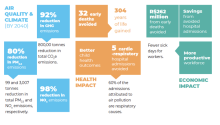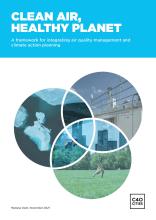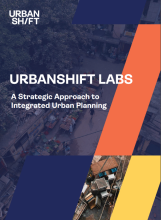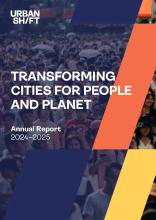How data and integrated planning approaches can help cities fight air pollution
Poor air quality threatens wellbeing everywhere. Learn how cities in Latin America are taking a data-driven approach to reducing pollution and promoting livability.
In Bogotá, Colombia, over 3,000 people die prematurely each year due to exposure to air pollution—namely PM2.5, a fine particulate matter produced by vehicle exhaust, burning and industrial outputs. Bogotá is not alone: According to 2021 data, of 174 cities in Latin America and the Caribbean, only 12 (7% percent) met the World Health Organization-recommended guidance for PM2.5 levels.
But Bogotá is also showing how data and integrated planning efforts can combat urban pollution and create more livable neighborhoods. “In Bogotá, we have widespread issues around proximity,” said Freddy Grajales, technical lead for the City of Bogotá’s Strategic Environmental Secretariat. “In many areas, activities are separated, which results in long vehicle trips that contribute to pollution, congestion, and crashes.” To counteract these concerns, the city has adopted a Barrios Vitales strategy, a data-informed effort inspired by Barcelona’s Superblock model and the concept of a 15-minute city. Through this strategy, Bogotá is redesigning five neighborhoods to centralize resources and encourage trips by foot and by bike—and subsequently, reduce pollution and improve the health and well-being of residents.
The work underway in Bogotá is just one example of how cities in Latin America are combining data analysis with integrated planning approaches to measurably reduce pollution and improve quality of life for people. On December 12, UrbanShift and WRI’s Air Quality program co-hosted a webinar on how Latin American cities are moving toward clean air for all. This work, said Beatriz Cardenas, Air Quality Director at WRI Mexico, is vital. “When it comes to air quality, there are no borders,” she said. Even if the sources of pollution are localized, their impacts spread across the globe and create ripple effects, from global warming to respiratory and cardiovascular illness to diminished agricultural outputs. With a diverse panel of experts, the webinar dove into the importance of data for air quality work, and how a strong analytical foundation can lead to projects, like Bogotá’s Barrios Vitales, with real impact.
Establish a baseline
In Mexico, the Guadalajara Metropolitan Area (AMG) is the second most populous urban center, and suffers from persistent high pollution levels and increasingly, the effects of climate change. Determined to reduce pollution in the region, the Metropolitan Planning Institute for Guadalajara (IMEPLAN) collaborated with WRI Mexico as well as the State of Jalisco to develop an integrated emissions inventory that identifies the sources of pollution in the region. “This tool calculates and compiles estimates of emissions that are the most significant for improving air quality, reducing the contribution of global warming and managing pollutants in the atmosphere in an efficient and effective way,” said Ana Cecilia Perales, Technical-Administrative Coordinator for Air Quality, WRI México Ross Center for Sustainable Cities. “In this way, it is possible to identify and quantify the sources, develop regulations, and also track the impact of urban air-quality interventions.”
Using this inventory as a baseline, WRI México has been able evaluate how a new BRT line in Guadalajara called Mi Macro Periférico, which runs for 42 kilometers (about 26.1 mi) around the periphery of the city, is impacting air quality. The team, Perales said, was able to determine that by substituting truck traffic with the new BRT line that uses diesel buses with the latest EuroVI low-emission technology, the region could avoid about 27 pollution-related cardiovascular deaths and around 715 lost workdays. “This is a very practical example of how the inventory information could help us demonstrate the effectiveness of an urban intervention,” Perales said.
Foster transparency and accountability
The impacts of poor air quality are universal. As cities grapple with high rates of pollution—both from local sources, like vehicle exhaust, and from climate-related impacts like wildfires—it's essential that they do what they can to inform and protect residents. Accurate data, said Sandra Meneses, Air Quality Coordinator with WRI Colombia, can offer residents up-to-date and actionable information about air quality in their cities, and help guide local interventions to mitigate high pollution levels.
CityAQ, a partnership between WRI, NASA Global Modeling and Assimilation Office (NASA-GMAO), and several cities including Addis Ababa, Bogotá, Jakarta, Kigali, Leon-Salamanca-Celaya Metro, Monterrey Metro, Guadalajara Metro and Sao Paulo, uses emissions inventories, satellite imagery and a local air quality data and machine learning to provide local air quality forecasts. “Participating cities can anticipate health-damaging pollution levels, communicate with stakeholders and manage local interventions more optimally and more effectively,” Meneses said.
Interested in learning more about CityAQ or how your city can participate? Get in touch.
Design for action and impact
Integrated planning approaches that emphasize sustainable transportation options and resource proximity, like Bogotá’s Barrios Vitales initiative, are a critical tool for cities aiming to reduce pollution. But it’s essential that they be able to quantify the benefits of these design approaches. In many Latin American cities, said Andrea Bizberg, Technical Advisor for C40’s Air Quality Climate Action Planning Project in Latin America, low-emission zones (LEZs) are garnering increased interest as a means to combat pollution. LEZs are designated areas within cities that impose stricter regulations to limit transport-related emissions through, for example, restricting high-emitting vehicles or limiting through traffic. While effective, LEZs often attract pushback, Bizberg said. We know with these low-emission zones, one of the main priorities is communicating the benefits of the project well to build support and achieve successful implementation.”
C40 Cities has developed a tool called AQUA (Air Quality through Urban Actions) which enables city staff to easily calculate the benefits of air quality interventions, pulling from population, exposure, health and economic cost data, as well as epidemiologic evidence. As Rio de Janeiro was planning for a low emission district, they were able to use AQUA to calculate the benefits of creating an electric-vehicle only district in the city. By 2040, the payoff for the city and its residents would be pronounced: emissions would decline by around 80%, while residents’ health outcomes would improve and the city would save millions from avoided health impacts and increased productivity. “With this base analysis, the city could, as a next step, put together a communication campaign built around these results to create buy-in,” Bizberg said.

Improving air quality is at the heart of UrbanShift’s approach. Each one of the initiative’s core focus areas—from nature-based solutions to integrated planning—are integral to efforts at the local and global scale to improve air quality. Urban greening makes a difference, as does fleet electrification and creating walkable and bikeable communities. The data and tools shared in this webinar are essential resources for cities undertaking multifaced approaches to create clean air for all.
Learn more about UrbanShift’s work with cities in our 2022-2023 Annual Report, and explore how WRI and C40 Cities are working to improve air quality across Latin America and worldwide.
READ MORE

Towards Clean Air for All in Latin American Cities: The Importance of an Integrated Approach
This webinar, hosted by World Resources Institute, explored how Latin American cities are using data to understand air quality challenges and incorporate mitigation strategies into larger planning efforts.

Clean air, healthy planet
This framework outlines steps for integrating air quality management and climate action planning at the city level. It supports cities to set visions and strategies to simultaneously tackle climate change, air pollution and public health issues.

UrbanShift Labs
Summarizing insights and lessons from eight of UrbanShift's Labs, this report offers a template for furthering geospatial analysis in cities.

UrbanShift Annual Report 2024-2025
UrbanShift's final Annual Report spans an impactful year of over 30 events and major progress across our network of 23 cities.

